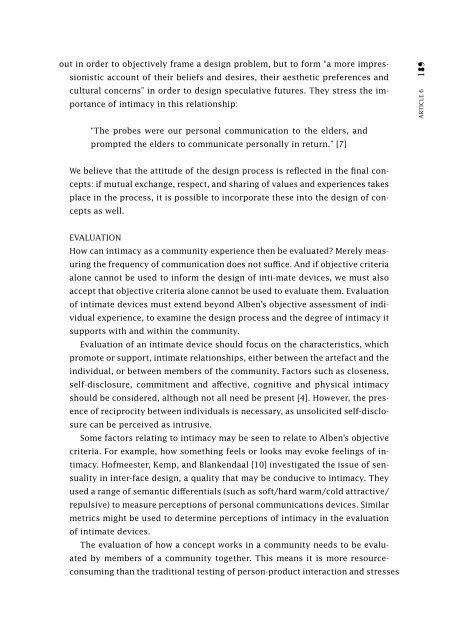Co-experience: Understanding user experiences in social interaction
Co-experience: Understanding user experiences in social interaction
Co-experience: Understanding user experiences in social interaction
Create successful ePaper yourself
Turn your PDF publications into a flip-book with our unique Google optimized e-Paper software.
out <strong>in</strong> order to objectively frame a design problem, but to form “a more impressionistic<br />
account of their beliefs and desires, their aesthetic preferences and<br />
cultural concerns” <strong>in</strong> order to design speculative futures. They stress the importance<br />
of <strong>in</strong>timacy <strong>in</strong> this relationship:<br />
ARTICLE 6 189<br />
“The probes were our personal communication to the elders, and<br />
prompted the elders to communicate personally <strong>in</strong> return.” [7]<br />
We believe that the attitude of the design process is reflected <strong>in</strong> the f<strong>in</strong>al concepts:<br />
if mutual exchange, respect, and shar<strong>in</strong>g of values and <strong>experience</strong>s takes<br />
place <strong>in</strong> the process, it is possible to <strong>in</strong>corporate these <strong>in</strong>to the design of concepts<br />
as well.<br />
EVALUATION<br />
How can <strong>in</strong>timacy as a community <strong>experience</strong> then be evaluated? Merely measur<strong>in</strong>g<br />
the frequency of communication does not suffice. And if objective criteria<br />
alone cannot be used to <strong>in</strong>form the design of <strong>in</strong>ti-mate devices, we must also<br />
accept that objective criteria alone cannot be used to evaluate them. Evaluation<br />
of <strong>in</strong>timate devices must extend beyond Alben’s objective assessment of <strong>in</strong>dividual<br />
<strong>experience</strong>, to exam<strong>in</strong>e the design process and the degree of <strong>in</strong>timacy it<br />
supports with and with<strong>in</strong> the community.<br />
Evaluation of an <strong>in</strong>timate device should focus on the characteristics, which<br />
promote or support, <strong>in</strong>timate relationships, either between the artefact and the<br />
<strong>in</strong>dividual, or between members of the community. Factors such as closeness,<br />
self-disclosure, commitment and affective, cognitive and physical <strong>in</strong>timacy<br />
should be considered, although not all need be present [4]. However, the presence<br />
of reciprocity between <strong>in</strong>dividuals is necessary, as unsolicited self-disclosure<br />
can be perceived as <strong>in</strong>trusive.<br />
Some factors relat<strong>in</strong>g to <strong>in</strong>timacy may be seen to relate to Alben’s objective<br />
criteria. For example, how someth<strong>in</strong>g feels or looks may evoke feel<strong>in</strong>gs of <strong>in</strong>timacy.<br />
Hofmeester, Kemp, and Blankendaal [10] <strong>in</strong>vestigated the issue of sensuality<br />
<strong>in</strong> <strong>in</strong>ter-face design, a quality that may be conducive to <strong>in</strong>timacy. They<br />
used a range of semantic differentials (such as soft/hard warm/cold attractive/<br />
repulsive) to measure perceptions of personal communications devices. Similar<br />
metrics might be used to determ<strong>in</strong>e perceptions of <strong>in</strong>timacy <strong>in</strong> the evaluation<br />
of <strong>in</strong>timate devices.<br />
The evaluation of how a concept works <strong>in</strong> a community needs to be evaluated<br />
by members of a community together. This means it is more resourceconsum<strong>in</strong>g<br />
than the traditional test<strong>in</strong>g of person-product <strong>in</strong>teraction and stresses

















